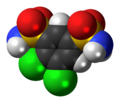Diclofenamide
Diclofenamide is a carbonic anhydrase inhibitor used to treat glaucoma and other conditions that involve fluid retention. It works by decreasing the amount of fluid that can build up in the eye. It also reduces the build-up of body fluids caused by congestive heart failure or certain medications.
Mechanism of Action[edit]
Diclofenamide works by inhibiting the enzyme carbonic anhydrase, which plays a key role in the production of aqueous humor in the eye. By inhibiting this enzyme, diclofenamide reduces the production of this fluid, thereby reducing intraocular pressure.
Uses[edit]
Diclofenamide is primarily used to treat glaucoma, a condition characterized by increased pressure within the eye. It can also be used to treat edema (fluid retention) due to congestive heart failure or certain medications.
Side Effects[edit]
Common side effects of diclofenamide include nausea, vomiting, loss of appetite, and tiredness. More serious side effects can include kidney stones, anemia, and drowsiness.
Contraindications[edit]
Diclofenamide should not be used in patients with hypersensitivity to sulfonamides, severe kidney or liver disease, or adrenal gland dysfunction.
Interactions[edit]
Diclofenamide can interact with other medications, including aspirin, corticosteroids, and digitalis.
Dosage[edit]
The dosage of diclofenamide varies depending on the condition being treated and the patient's response to treatment.
See Also[edit]
Ad. Transform your life with W8MD's Budget GLP-1 injections from $75


W8MD offers a medical weight loss program to lose weight in Philadelphia. Our physician-supervised medical weight loss provides:
- Weight loss injections in NYC (generic and brand names):
- Zepbound / Mounjaro, Wegovy / Ozempic, Saxenda
- Most insurances accepted or discounted self-pay rates. We will obtain insurance prior authorizations if needed.
- Generic GLP1 weight loss injections from $75 for the starting dose.
- Also offer prescription weight loss medications including Phentermine, Qsymia, Diethylpropion, Contrave etc.
NYC weight loss doctor appointmentsNYC weight loss doctor appointments
Start your NYC weight loss journey today at our NYC medical weight loss and Philadelphia medical weight loss clinics.
- Call 718-946-5500 to lose weight in NYC or for medical weight loss in Philadelphia 215-676-2334.
- Tags:NYC medical weight loss, Philadelphia lose weight Zepbound NYC, Budget GLP1 weight loss injections, Wegovy Philadelphia, Wegovy NYC, Philadelphia medical weight loss, Brookly weight loss and Wegovy NYC
|
WikiMD's Wellness Encyclopedia |
| Let Food Be Thy Medicine Medicine Thy Food - Hippocrates |
Medical Disclaimer: WikiMD is not a substitute for professional medical advice. The information on WikiMD is provided as an information resource only, may be incorrect, outdated or misleading, and is not to be used or relied on for any diagnostic or treatment purposes. Please consult your health care provider before making any healthcare decisions or for guidance about a specific medical condition. WikiMD expressly disclaims responsibility, and shall have no liability, for any damages, loss, injury, or liability whatsoever suffered as a result of your reliance on the information contained in this site. By visiting this site you agree to the foregoing terms and conditions, which may from time to time be changed or supplemented by WikiMD. If you do not agree to the foregoing terms and conditions, you should not enter or use this site. See full disclaimer.
Credits:Most images are courtesy of Wikimedia commons, and templates, categories Wikipedia, licensed under CC BY SA or similar.
Translate this page: - East Asian
中文,
日本,
한국어,
South Asian
हिन्दी,
தமிழ்,
తెలుగు,
Urdu,
ಕನ್ನಡ,
Southeast Asian
Indonesian,
Vietnamese,
Thai,
မြန်မာဘာသာ,
বাংলা
European
español,
Deutsch,
français,
Greek,
português do Brasil,
polski,
română,
русский,
Nederlands,
norsk,
svenska,
suomi,
Italian
Middle Eastern & African
عربى,
Turkish,
Persian,
Hebrew,
Afrikaans,
isiZulu,
Kiswahili,
Other
Bulgarian,
Hungarian,
Czech,
Swedish,
മലയാളം,
मराठी,
ਪੰਜਾਬੀ,
ગુજરાતી,
Portuguese,
Ukrainian




